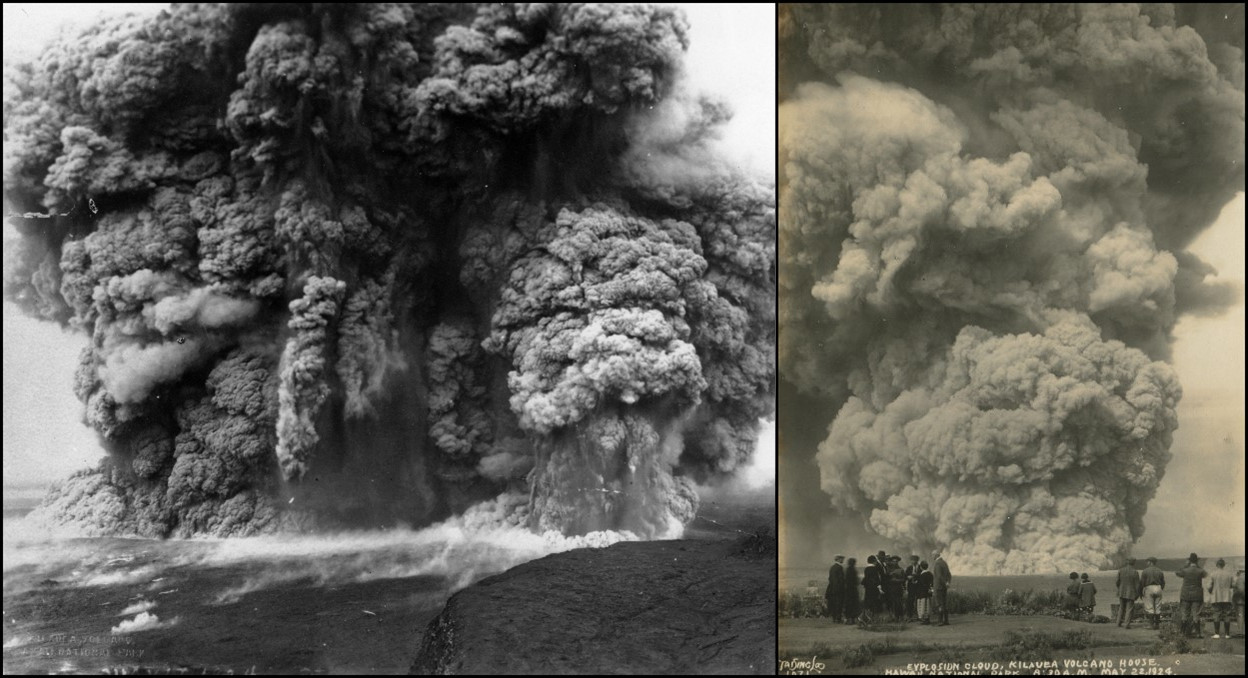(BIVN) – From this week’s Volcano Watch article, written by USGS Hawaiian Volcano Observatory research geologist Drew Downs:
May 2023 marks the 99th anniversary of a sequence of explosive eruptions from Kīlauea’s summit that occurred over 16 days from May 11–27, 1924. During this eruption, about 60 explosions occurred from Halemaʻumaʻu with fragments ranging from volcanic ash to large blocks the size of cars falling around the summit caldera.
For nearly two decades prior to the explosive eruptions in 1924, Halemaʻumaʻu hosted a large lava lake. In February 1924, this lava lake drained over the course of 2 days, leaving behind an incandescent crater that was around 380 ft deep by 1,700 ft wide (115 m deep by 520 m wide). Halemaʻumaʻu remained an empty crater for the next 2 months.
April 1924 saw the summit of Kīlauea hit with an earthquake swarm that migrated down the East Rift Zone. Residents of Kapoho in the lower East Rift Zone felt more than 200 earthquakes on April 22–23, which resulted in an approximately 4-mile-long by 1-mile-wide (6.5 by 1.6 km) tract of land cracking and subsiding. This included the area near the eastern point of the Island of Hawaiʻi dropping by about 14 ft (4 m) and the ocean covering nearly a half mile (1 km) of previously dry land. Despite the shaking and subsidence in the lower East Rift Zone, associated with lava draining from the summit lava lake, no eruption occurred from the rift zone.
On April 29, 1924, the floor of Halemaʻumaʻu started to subside and eventually reached around 600 ft (180 m) below the crater rim by the time the first explosions occurred from Halemaʻumaʻu during the nighttime hours of May 10–11. Hot rocks from this explosion were noticed near the rim of Halemaʻumaʻu on the morning of May 11 by a National Park Ranger. This prompted road closures within Hawaii National Park (as it was named then), as well as a close call when the park superintendent and two observers were pelted by ash during another explosion that sent ash up to 3,000 ft (nearly 1 km) high. In fact, a 100 lbs. (45 kg) boulder had been thrown over the group’s vehicle nearby, prompting the roadblock to be pushed back even farther.
Explosions of ash, lapilli, and blocks continued to be ejected from the crater. The largest of these explosions occurred on May 18 with lightning-charged ash going up higher than 4 miles (6.5 km), as well as spreading across the crater floor. Several people were near the crater rim when this explosion occurred. Unfortunately, a resident of Pāhala was hit by a block and died that night at the hospital in Hilo. This was the only fatality during these explosive eruptions.
Explosions continued, although smaller than the one on May 18, and by May 27, when the explosions ended, Halemaʻumaʻu was about twice as wide and eight times as deep than prior to the sequence of explosions. Blocks weighing as much as 8 tons (8,000 kg, equivalent to 10 cows) had been hurled as much as 1,600 ft (500 m) from the crater.
Scientists originally proposed that the lava lake draining exposed cracks in the crater floor that allowed groundwater to enter the system. This groundwater may have flashed to steam and resulted in the many explosions over the 16 days in May 1924. However, new research being undertaken by the Hawaiian Volcano Observatory could reveal other explanations for these explosive events. This research will help us to better understand these explosive bursts that occurred nearly a century ago and compare them with the more recent explosions from the summit of Kīlauea in 2018.


by Big Island Video News6:44 pm
on at
STORY SUMMARY
HAWAIʻI ISLAND - This week's Volcano Watch article examines the 60 explosions occurred from Halemaʻumaʻu in March 1924.